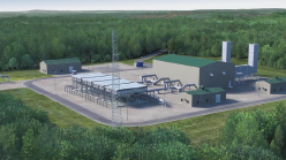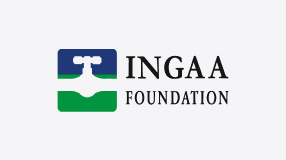Over the past decade, perhaps no external factor has influenced the energy industry more than technology. From the wide spread use of automated real-time telemetry to using the Internet to conduct daily operations such as nominations, scheduling, and invoicing, technology has drastically changed the way and the speed in which we conduct business. New e-procurement processes have begun to influence and shape many industries. INGAA realized the impact e-procurement was beginning to have on the energy industry and contacted PricewaterhouseCoopers to perform a survey of their membership regarding e-procurement.
In August 2000, PricewaterhouseCoopers delivered to The INGAA Foundation a report on e-procurement based upon surveys completed by INGAA members. Fifty companies involved in the natural gas industry completed the surveys. The purpose of the survey was to capture information from companies in the interstate pipeline industry regarding their plans for on-line procurement of goods and services in the future. As the industry prepares for the implementation of e-procurement, a series of steps needs to be to followed to allow for an orderly progression of events. Pipelines and pipeline suppliers are starting to develop e-procurement models and modifying their business practices accordingly. Coordination at the beginning stages of these modifications will prevent the need for future changes if the models are significantly different. As the survey results were discussed at the membership meeting, the following next steps were proposed by members of INGAA to assist in developing e-procurement standards for the natural gas pipeline industry:
- Define products,services and parts that are candidates for being traded through an on-line e-procurement process
- Find costs in the existing procurement systems that are the result of system inefficiencies
- Define information that could be shared to help the industry as a whole plan better without violating anti-trust laws
This project was designed to address the first two bullet points. The last bullet point should be addressed by appropriate legal counsel.
Based on the discussions and meetings, our conclusions are summarized in the section below. In order to bring to light specific trends and important conclusions, we have grouped our conclusions according to specific areas.
Overall
The in-depth discussions performed as part of this project have verified many of the findings in our initial report. Overwhelmingly, companies believe e-procurement will impact the industry in the short to medium timeframe, 1-3 years. Suppliers feel that they are going to be impacted the most with a strong number believing that e-procurement will have a large impact on their business. Many suppliers view their purchaser relationships with the pipelines as large competitive assets. The suppliers feel that if their product is viewed as a commodity, then the reputations of their business for on- time performance, quality of product, and overall commitment to the pipelines will cease to matter. If e- procurement diminishes the importance of the supplier reputation, large changes by the suppliers may be required if competitive advantages are to be maintained.
Definition of E- Procurement
There is a great disparity in the definition of e- procurement among the companies interviewed. The definition ranges from e- procurement being a bid submitted via e- mail to applications linked between buyer and supplier where orders and invoices flow electronically. For the purposes of our discussions and this report, we define e- procurement as the use of technology to augment the procurement process in the pipeline industry. This may range from simply connecting supplier and purchaser accounting systems to full- scale automation of the entire industry’s procurement process via e- catalogs and on- line marketplaces. This would generally include sophistication greater than an e- mailed bid package.
Products and Services
Discussions with companies throughout the industry revealed that the more customized a product or service, the less likely those companies would be to offer or purchase the item in an e- procurement setting. At each facilitated discussion, we asked both suppliers and pipelines to rank the e- procurement opportunities for various pipelines supplier types. The average results are presented in the table on the next page with 1 meaning no opportunities for e- procurement, 2 meaning few opportunities for e- procurement, 3 meaning some opportunities for e- procurement, and 4 meaning many opportunities for e- procurement.
Overall, the pipelines have initiated more e- procurement projects in other facets of their business than their suppliers have. The pipelines are already participating in e- procurement transactions with their MRO suppliers in most cases, which include mostly non- complex higher volume items such as safety, electrical and janitorial supplies, motors, and pumps. This has been the largest e- procurement initiative for most of them. The large differences in the views between the suppliers and the pipelines in some areas illustrate the need for further dialogue to address the views and concerns of each. The pipelines have initiated more e- procurement initiatives with their suppliers than the pipelines’ suppliers have with their suppliers. Many of the pipelines have e- catalogs with their MRO suppliers, and some have initiated reverse auctions.
Inefficiencies in the Current Procurement Model
Our discussions did not uncover any large inefficiencies in the current procurement model. While the pipelines viewed reduction in sales force as cost savings to the supplier, the suppliers believed that a sales force would still be needed. A sales force would be needed to maintain relationships with the pipelines, to keep the supplier on the bid list, and to introduce new products and services to the pipelines. Both viewed the lack of standards, deviations from existing standards, incomplete "request for bid" packages, and incomplete bid responses as areas for improvement. However, most of these areas will need to be addressed before e- procurement can be successfully implemented.
Next Steps
The next steps that the Natural Gas Industry needs to take are as follows:
1. Suppliers need to understand how they can benefit from e- procurement. Many see e- procurement as an attempt to drive down costs without an even distribution of benefits across all participants. The pipelines can only push the incentive so far without support from the other side of the transaction.
2. Facilitation is needed between the buyers and sellers to clarify the e- procurement goals and address concerns of both sides.
3. Standardization of product specifications and e- procurement solutions is also needed. Without standard product specifications, electronic purchasing or bidding of products is difficult. Follow- up conversations need to take place to clarify the specific requirements.
4. The industry should consider developing an e- procurement business model for a single area such as pipeline distribution, or engineering services, in order to determine benefits and efficiencies gained, as well as issues and processes prior to embarking on a formal initiative. This business model could be developed by an appropriate industry focus group from the INGAA membership, along with a third party facilitator which would present their findings at a general session held by INGAA. This model could prove out the need for the natural gas pipeline industry to move toward e- procurement capabilities or could also prove that it would not work in our current business environment.





